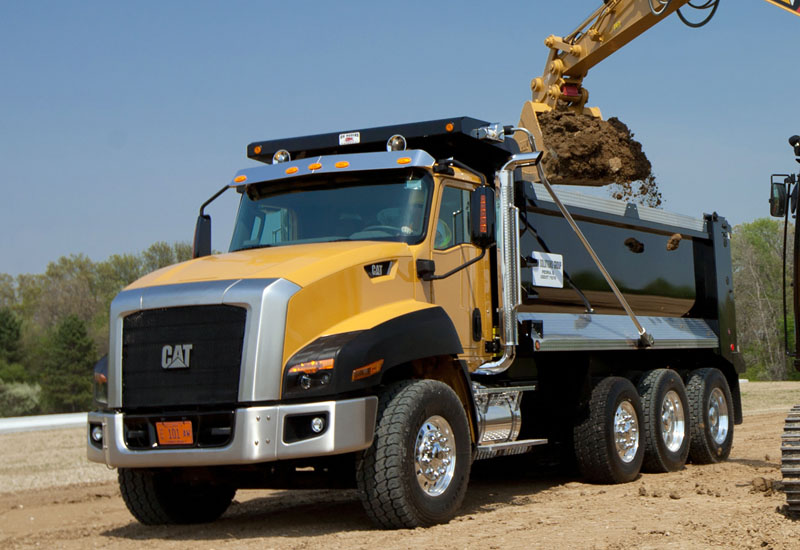Caterpillar has launched the 725C2 and 730C2 articulated dump trucks in Middle East markets, completing a range that delivers modest changes but considerable advantage on its predecessors.
“The changes are quite easy to sum up — which is why it is called the C2 and not the next Series up,” explains Julien Balardelle, product application specialist for articulated dump trucks at Caterpillar. “The big change for us under the C2 umbrella is the adoption of the all-enclosed wet axle brake on the 725 and the 730 — the larger machines having had wet axle braking for a number of years now.”
Moving from dry disc brakes, this protects the braking system from dust, dirt and any contamination that could enter the braking system on previous units. With the increased braking performance and reduced maintenance of a fully enclosed system, Balardelle highlights that there is a lowering of the operating and ownership costs for the product line.
Alongside the upgrade to the brakes, the 725C2 also delivers fully automatic traction control — a feature already on the larger C-Series models, but not previously available on Cat’s 25t-class articulated dump truck models.
Balardelle continues: “That’s basically removing the need for the operator having to press switches to lock the differentials. Instead there is a system that measures wheel speed and compares that to the ground speed of the machines and applies the differential locks.”
Automatic traction control is not a feature that every manufacturer is bringing out, but Caterpillar first introducing it with the larger B-Series articulate dump truck models.
Balardelle notes: “Our competitors have adopted it within reason, but we are the only one to have a fully automated system. They have a semi-automated system that automates one of two locks — but one or the other — and it still involves a manual switch for the operator.
He expands: “The reason why we have worked on it for a number of years is that the operation of an articulated truck, on average, is correlated with low-skilled operators.
“If you have a good operator on site, you will put that person on an excavator, a dozer or a grader — but a less-skilled operator is more likely to end up on an articulated truck. It is quite a skill to know when to apply the differentials in order to avoid abusing the machine.”
The automatic system removes that risk as a source of concern for owners and operators.
Caterpillar has also launched a version of the 730C2 articulated dump truck with an ejector-type body — where the rigid tipper body is also equipped with a hydraulic ram and blade to assist the dumping of material.
This lowers the risk of the machine tipping over when operating on slopes, and provides a range of potential benefits — though these are very much dependent on the application.
However, it is the simplifying measures of the all-enclosed wet axle brakes on both the 725 and 730 and the fully automatic traction control on the 725 that have generated the most interest among Caterpillar’s customers.
Balardelle notes: “We are the only brand out there using all-enclosed disc locks, and in terms of the feedback from the customer, they are really pleased with that system. It is just one less headache from a plant manager’s point of view — with them no longer having to make sure that operators are fully trained and know when to apply the differential.”
Caterpillar has also introduced a feature called RIB (retarder integrated braking) that informs the operator when they may be abusing the service brakes and proactively engages the retarder when applying the service brakes.
DUMPING DECISIONS
While articulated dump trucks are a naturally versatile, there are circumstances and applications where an off-highway truck or rigid dump truck may be more productive. The 725 and 730 cannot travel on highways (depending on the country), but can do the quarry work done by Cat’s 772 and 773 rigid dump trucks.
Balardelle details: “For similar payloads, an off-highway truck may be a slightly less costly option, but it will also be limited to good, dry, whole-road conditions — as soon as it is wet or the road worse, not only can an articulated dump truck produce more tonnes per hour, but it will achieve a lower cost per tonne.”
The gradient is another dynamic in the respective productivity of the vehicles, as off-highway trucks are more cost-efficient to run below a 15% gradient. Above this is “articulated territory” and an off-highway truck will not be as cost-efficient as an articulated truck.
Balardelle adds: “You’ve got some customer that think one is better than the other, but with the B- and C-Series we have improved the productivity drastically. We have improved the fuel efficiency versus other product offerings within Cat, as well as with the competition.”
Finally, Caterpillar has introduced a feature on the articulate trucks called Cat Production Measurement (CPM) that allows the customer to monitor and manage the productivity of their trucks by measuring the loaded payload against the target payload and indicating overloading or underloading to the operator.
Overall, Balardelle sums: “We are quite confident that with the C-Series on the larger machines and the C2 Series on the smaller machines we will grow our market share. We have already seen some market share growth with customers that we wouldn’t even have been considered by in the past — so overall we are improving in the Middle East.”




